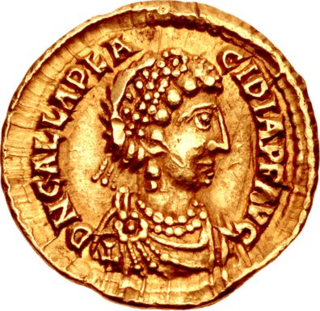
Galla Placidia, daughter of the Roman emperor Theodosius I, was a mother, tutor, and advisor to emperor Valentinian III. She was queen consort to Ataulf, king of the Visigoths from 414 until his death in 415, briefly empress consort to Constantius III in 421, and managed the government administration as a regent during the early reign of Valentinian III until her death.
The 430s decade ran from January 1, 430, to December 31, 439.
The 420s decade ran from January 1, 420, to December 31, 429.
The 450s decade ran from January 1, 450, to December 31, 459.
The 440s decade ran from January 1, 440, to December 31, 449.
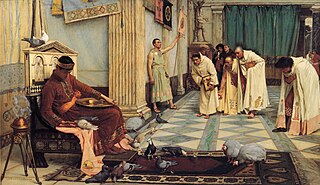
Year 423 (CDXXIII) was a common year starting on Monday of the Julian calendar. At the time, it was known as the Year of the Consulship of Marinianus and Asclepiodotus. The denomination 423 for this year has been used since the early medieval period, when the Anno Domini calendar era became the prevalent method in Europe for naming years.
Year 425 (CDXXV) was a common year starting on Thursday of the Julian calendar. At the time, it was known as the Year of the Consulship of Theodosius and Valentinianus. The denomination 425 for this year has been used since the early medieval period, when the Anno Domini calendar era became the prevalent method in Europe for naming years.

Marcian was Roman emperor of the East from 450 to 457. Very little of his life before becoming emperor is known, other than that he was a domesticus who served under the commanders Ardabur and his son Aspar for fifteen years. After the death of Emperor Theodosius II on 28 July 450, Marcian was made a candidate for the throne by Aspar, who held much influence because of his military power. After a month of negotiations Pulcheria, Theodosius' sister, agreed to marry Marcian. Zeno, a military leader whose influence was similar to Aspar's, may have been involved in these negotiations, as he was given the high-ranking court title of patrician upon Marcian's accession. Marcian was elected and inaugurated on 25 August 450.
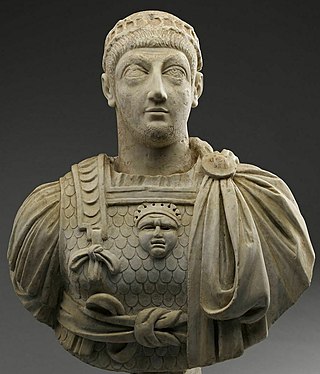
Valentinian III was Roman emperor in the West from 425 to 455. Starting in childhood, his reign over the Roman Empire was one of the longest, but was dominated by civil wars among powerful generals and the invasions of late antiquity's Migration Period.

Flavius Aetius was a Roman general and statesman of the closing period of the Western Roman Empire. He was a military commander and the most influential man in the Empire for two decades (433–454). He managed policy in regard to the attacks of barbarian federates settled throughout the West. Notably, he mustered a large Roman and allied (foederati) army in the Battle of the Catalaunian Plains, ending a devastating invasion of Gaul by Attila in 451, though the Hun and his subjugated allies still managed to invade Italy the following year, an incursion best remembered for the ruthless Sack of Aquileia and the intercession of Pope Leo I.
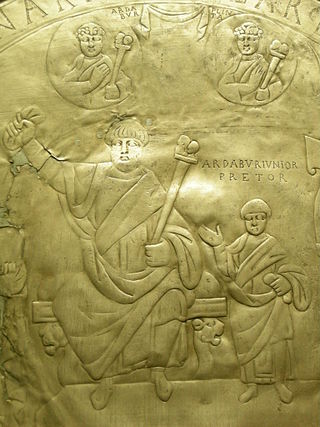
Flavius Ardabur Aspar was an Eastern Roman patrician and magister militum of Alanic-Gothic descent. As the general of a Germanic army in Roman service, Aspar exerted great influence on the Eastern Roman Emperors for half a century, from the 420s to his death in 471, through the reigns of Theodosius II, Marcian and Leo I, who, in the end, had him killed. His death led to the ending of the Germanic domination of Eastern Roman policy.
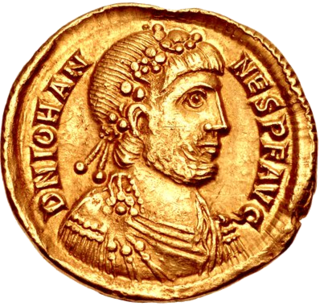
Joannes or John was Western Roman emperor from 423 to 425.
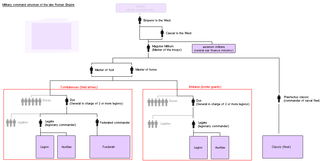
Magister militum was a top-level military command used in the late Roman Empire, dating from the reign of Constantine the Great. The term referred to the senior military officer of the empire. In Greek sources, the term is translated either as strategos or as stratelates.
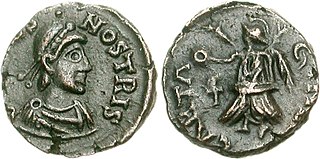
Bonifatius was a Roman general and governor of the diocese of Africa. He campaigned against the Visigoths in Gaul and the Vandals in North Africa. An ally of Galla Placidia, mother and advisor of Valentinian III, Bonifacius engaged in Roman civil wars on her behalf against the generals Felix in 427-429 and Aetius in 432. Although he defeated the latter at the Battle of Rimini, Bonifacius suffered a fatal wound and was succeeded by his son-in-law Sebastianus as patricius of the Western Roman Empire.

The Valentinian dynasty was a ruling house of five generations of dynasts, including five Roman emperors during late antiquity, lasting nearly a hundred years from the mid fourth to the mid fifth century. They succeeded the Constantinian dynasty and reigned over the Roman Empire from 364 to 392 and from 425 to 455, with an interregnum (392–423), during which the Theodosian dynasty ruled and eventually succeeded them. The Theodosians, who intermarried into the Valentinian house, ruled concurrently in the east after 379.

The Gothic revolt of Theodoric I was an uprising of the Gothic Fouderati in Aquitaine during the regime of Emperor Valentinian III (425-455). That rebellion was led by Theodoric I, King of the Visigoths and took place in the South of France. The uprising took place between 425 and 426, in the period shortly after the death of usurpator John and was terminated by a military operation under the command of Aëtius.

The Roman Civil War (432) was a military conflict between the Roman generals Aëtius and Bonifatius during the reign of Emperor Valentinian III. This war took place on Italian soil and was decided in the Battle of Rimini. Despite Aëtius losing the battle, the civil war ended in his favor, because Bonifatius was wounded in battle and eventually died of his injuries.

The Roman civil war of 427-429 was a civil war during the reign of the West Roman emperor Valentinian III. In that period there was a power struggle going on between the generals Felix and Bonifatius that degenerated into an armed conflict. When the central government tried to deput Bonifatius as governor of North-Africa, he separated his territory from the empire without proclaiming himself emperor. He carried the personal loyalty of the African troops and lead them at his discretion during this war. Bonifatius was able to successfully defy and resist state authority. The civil war ended with a truce after which peace was made.

The Frankish War was a short military conflict between the Frankish people and the West Roman Empire under Emperor Valentinian III. In this conflict, it can only be said with certainty that the Roman general Aetius was involved in it. The presence of King Chlodio of the Salians as captain of the Franks is an assumption and is not confirmed by contemporary sources. The war ended in a Roman victory.

Aetius' campaign in the Alps was a military campaign of the Roman army in the northern Alpine region, where the dioceses Raetia and Noricum were situated. The campaign was directed against the Juthungi and the rebellious population of Noricum. The command of the campaign was in the hands of magister militium Aëtius and it began in the spring of 430 CE. In May, the campaign was interrupted to continued the following year.













